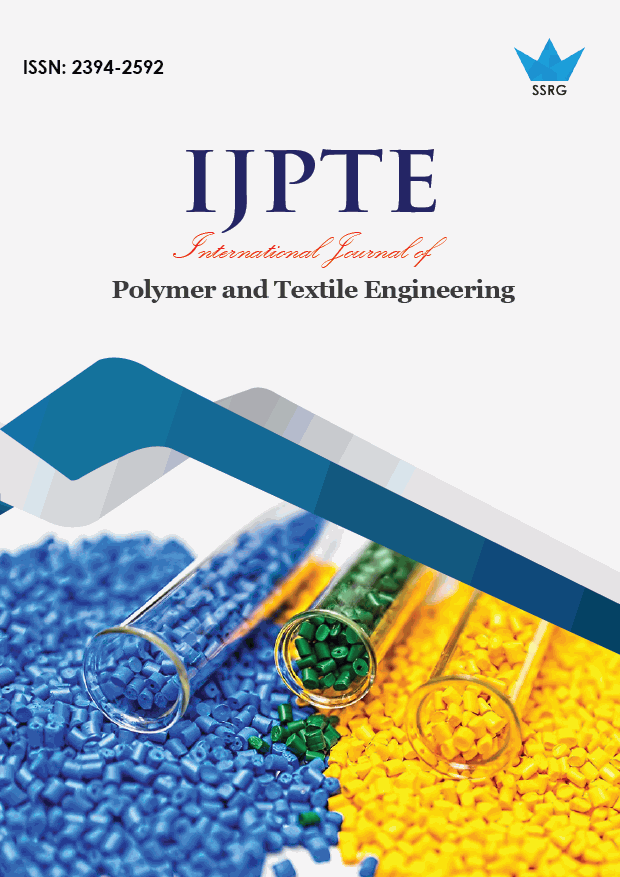Consumer Preferences in Fragranced Textiles

| International Journal of Polymer and Textile Engineering |
| © 2020 by SSRG - IJPTE Journal |
| Volume 7 Issue 1 |
| Year of Publication : 2020 |
| Authors : Jasmina Panchal, Suman Mundkur |
How to Cite?
Jasmina Panchal, Suman Mundkur, "Consumer Preferences in Fragranced Textiles," SSRG International Journal of Polymer and Textile Engineering, vol. 7, no. 1, pp. 59-62, 2020. Crossref, https://doi.org/10.14445/23942592/IJPTE-V7I1P108
Abstract:
In our daily lives, everybody is connected with textiles like personal clothing, home furnishing etc. Textiles fabrics have an inheritant scent in the form of raw materials or after the manufacturing process. The special finishes that are applied on the fabric may give a smell or fragrance is called Aromachology. Aroma finishes are the process by which textile materials are treated with the pleasant odor producing essential oils and aromatic compounds so that the wearer gets some beneficial effects. Eessential oils like lavender, rosemary and jasmine are used to give this type of finish. Fragrance acceptance will differ from person to person. A survey conducted with the purpose of understanding the awareness, preferences and the potential use among young working women in Mumbai. A sample of 30 working women, in the age group of 21 to 50 years of age were selected by purposive sampling. Data was collected through online questionnaire containing close-ended and matrix type of questions. The data was analysed by finding the mean of responses and interpreted. According to the results, majority of the respondents are aware about fragrance textile. It was found that some already had the experience of using fragranced textiles, some others had read or had heard from others about fragranced textiles. The level of awareness was therefore found to be high for the fragrances applied onto fabrics. The respondents indicated their preference in fragrances from a select range of fragrances under the study. The results also showed that majority of respondents expressed their desire to use fragranced textiles in their daily lives; in clothes and wanted fragrances in home textiles.
Keywords:
Arachnology, consumer acceptance, fragrance textiles, mood.
References:
[1] Alessandro, Caseareo (2017): Artistic Finishes for Home Textile Materials, SSRG International Journal of Polymer and Textile Engineering (SSRG-IJPTE), Volume 4 Issue 2.
[2] Dr. West. A. J. and Dr. Annett-Hitchworlk. K. E (2014), A Critical Review of Aroma Therapeutic Applications for Textiles. Journal of Textiles and Apparel, Technology and Management, volume 9:1.
[3] Karolia, A. and Mendapara. S. (2007): Imparting antimicrobial and fragrance finish on cotton using chitosan with silicon softener. Indian Journal of Fibre & Textile Research. Vol. 32, March 2007, pp. 99-104.
[4] Lim. P and Setthyanond. J. (2019): Factors Affecting Release of Microencapsulated Essential oils from finished Silk fabric fro Home and Automotive Textile products. International Journals of Engineering and Advanced Technology. Volume 8:3.
[5] Liu, Y., Tovia, F. and K. Belasubramian (2008): Scent Infused Textiles to Enhance Consumer Experiences. Journal of Industrial Textiles, Vol. 3: No. 3. January 2008. [6] Mazharul Islam Kiron. (n. d.). Aroma Textile: Application of Aromatherapy on Textiles. Retrieved from https://textilelearner.blogspot.com/2013/03/aroma-textile-application-of.html
[7] Pan, N.C. & Samanta, K.K. & Ammayappan, Lakshmanan & Khan, A.. (2017). Aroma finishing of textiles. Man-Made Textiles in India. 45. 93-95. [8] Paul, R. (2017). Functional Finishes For Textiles. Place of publication not identified: Woodhead Publication.
[9] Tabassum. A, Muhammad. A, Hussain. A, Nighat. B, Zafar. J. (2015), Effect of Fragrance finish on Mechanical and Comfort Properties of Digitally Printed Fabric. Journal of Textile and Engineer, Vol. 22: 97.
[10] Thilagavathi. G and Kannaian.T. (2010). Combined antimicrobial and aroma finishing treatment for cotton, using micro-encapsulated geranium (Pelargonium graveolens L’ Herit. ex Ait.) leaves extract Indian Journal of Natural Products and Resources. Vol.1 (3), pp. 348-352.
[11] Wang C. X. Chen Sh. L: Aromachology and its Application in the Textile Field, Fibers and Textiles in Eastern Europe January / December 2005, Vol. 13: 6 (54).

 10.14445/23942592/IJPTE-V7I1P108
10.14445/23942592/IJPTE-V7I1P108